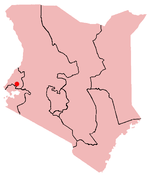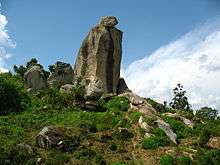Kakamega
- Kakamega is also the genus of the Grey-chested babbler (Kakamega poliothorax), a bird

Kakamega is a town in western Kenya lying about 30 km north of the Equator. It is the headquarters of Kakamega County. The town has a population of 99,987 (2009 census).[1]
Kakamega is 52 km north of Kisumu, the third largest city in Kenya and a port city on Lake Victoria. The average elevation of Kakamega is 1,535 metres.
Kakamega county is Kenya's second most populous county after Nairobi. The county has 9 constituencies in total, namely Butere, Mumias East, Matungu, Khwisero, Shinyalu, Lurambi, ikolomani, Lugari and Malava.
Kakamega was so named because the word "kakamega" translates roughly to "pinch" in Kiluhyah, which was used to describe how European colonists would eat the staple food, ugali.
Naming
Kakamega derives its modern name from the local dialect. The story goes that when European settlers first visited the area now known as Kakamega and were offered maize meal, the local staple food called Obusuma, they tried to emulate the eating style for which the tribe was famous. To the hosts though, the visitors were more like ‘pinching’ the Obusuma. The resulting administrative area was named ‘Kakamega’, which roughly translates to ‘pinch.’[2]
Economics

Local Inhabitants are mostly the Luhya tribe, whose economic activity is mainly farming and fishing.
Kakamega serves as the headquarters of Kenya's largest sugar producing firm, Mumias Sugar, located in the town of Mumias.[3]
Kakamega was the scene of the Kakamega gold rush in the early 1930s, fueled partly by the reports of the geologist Albert Ernest Kitson.[4]
Masinde Muliro University of Science and Technology is a new institution of higher learning created by an act of parliament in December 2006 which is in the heart of Kakamega town on the Kakamega-Webuye road. It is expected to spur growth in this capital of Western Province.
Kakamega Forest is the main tourist destination in the area. Another attraction is the Crying Stone of Ilesi located along the highway towards Kisumu. It is a 40 metres high rock dome resembling a human figure whose "eyes" drop water.[5]
Administration
In the recently concluded elections, Wycliffe Oparanya was voted as the first Governor of Kakamega County. Kakamega forms a municipality with ten wards (Amalemba, Bukhulunya, Central, Mahiakalo, Maraba, Matende, Milimani, Musaa, Shibiriri and Sichilayi). All of them belong to Lurambi Constituency, which has a total of fifteen wards. The remaining five are located within Kakamega municipal Council, the rural council of Kakamega District.[6]
Rainforest
Kakamega area receives a very high amount of annual precipitation and contains Kakamega Forest, a preserve which is a remnant of a rainforest that stretched west through Uganda.
As a rainforest, the canopy of the trees has grown into a thin mesh of interlocking top branches that block most sunlight from reaching the ground below, resulting in less vegetation at the ground level. With few bushes along the darkened forest floor, the main obstacle is ancient fallen tree trunks blocking the paths between the standing trees. The German funded project BIOTA East is working in the forest since 2001, whereby firstly forest inventories for all sorts of life forms were performed and the aim is to find strategies for a sustainable use of the forest.
More than 400 species of birds have been found in the Kakamega rainforest. The many song birds fill the air with various birdcalls.
Kakamega is also home to Africa's largest and most aggressive cobra, the Kakamega forest cobra. Reputed by locals to spend a lot of time in the trees, stories abound of fearsome attacks on unsuspecting passers-by. Other snakes in the area include the forest adder, black mamba, and the green mamba.
Forest Tour Guide
There are official guides in Kakamega rainforest who take tourists visiting the forest around in the forest nature trails, and they explain the biodiversity of Kakamega forest. Most of the tour guides have participated in various areas of research into the biology of the forest, and they are thus well qualified to describe the area. The guides will also tell visitors about Luyhia (Luhya) cultural practices such as circumcision and bullfighting, and give information about the medicinal plants in Kakamega forest. Guiding association in Kakamega forest
International Not-for-profit Activity
Although Kakamega is not the focus of a large number of aid agencies, some international non-profits are involved in the area. Among them are the ones listed below.
CES Canada (Community Education Services Canada), established in 2004, is a Canadian non-profit organization based in the greater Toronto area. In July 2013 CES Canada was granted Special Consultative status with the United Nations. Focusing on the four cornerstones of Education, Water, Health and Nutrition, it provides access to secondary education for Kenyan youth orphaned by HIV/AIDS. In partnership with CES Kenya, CES has provided 1500 scholarships in 26 secondary schools located in Kakamega, Navakholo and Bungoma Counties of rural western Kenya. 320 students have earned the KCSE with over half going on to higher learning. The CESCED (CES School of Continuing Education) Leadership training programs offer ICT studies, teacher internships and seminars on healthy living and personal growth. Health initiatives include the PAD Feminine Hygiene program, the provision of anti-malaria mosquito nets and health/hygiene kits for 250 students each year, clean water wells, hand washing stations, and the IC2 Read Eyewear Project. In 2013 the CES De-Worming Project provided education and medication for 50,000 primary school children. Nutrition outreach includes Dairy and Poultry farms with vegetable gardens in 5 schools. CES has built one secondary school, a Dormitory for 80 girls, 2 Science Labs, 2 Computer Labs and a Kitchen. In 2011 CES initiated the annual Canada Day Run held at Masinde Muliro University. CES Canada has 6 chapters in Thunder Bay, Calgary, Ottawa, Parry Sound-Muskoka, New Brunswick, and Kyoto, Japan. [7]
The primary mission of KEEF is to provide scholarships for very bright students from Kakamega County in Western Kenya who do not have the financial means to pay the fees for secondary and post-secondary schools in Kenya. KEEF was established in 2004 under the Society Act of British Columbia and was granted charitable status by The Canada Revenue Agency in 2006. KEEF is a nonprofit organization, not affiliated with any government or religious organization. KEEF’s Board of Directors from British Columbia, Canada, is represented in Kakamega by volunteers who interview and select students meeting the academic criteria and showing a proven need for assistance. KEEF works with local Kenyan communities through personal involvement and close collaboration. [8]
Kakamega Orphan Project is a Quaker-founded initiative that helps support the education and well-being of orphans and other vulnerable young people. Th organization supports over 150 elementary school and 150 high school students, as well as college students and programs for out of school youth. It is funded primarily by a US partner organization, the Friends of Kakamega.[9]
ACCES (African Canadian Continuing Education Society) is a Canadian non-profit that provides a suite of programs to foster social and economic improvements among the poorest of the poor, both in rural areas and the slums of Kibera in Nairobi. The flagship program of ACCES is providing post-secondary scholarships to bright and needy students from poor families. More than 2,000 students have graduated with an ACCES scholarship since 1993, and many are now at the top of their professions. The alumni have started an association (ACCES Alumni Association - AAA) which now sponsors secondary students through donations from its members. As of 2013, more than two million shillings has been raised and an endowment fund started with more than one million shillings to continue helping poor students to access higher education. ACCES also partners with the Ministry of Education to enhance primary schools in poor rural areas, including teacher training, learning and teaching materials, construction of classrooms and subsidies for poor families who cannot afford to access education for their children. ACCES also provides community development activities through its network of partnerships, such as the Kenya Agricultural Research Institute, Ministry of Agriculture, Kenya Environmental Research Program and many others. Using an integrated approach, ACCES brings income generation, agri-busimness, health, hygiene, clean water, gender equity, child rights, and governance to help communities become self-sufficient and sustainable. ACCES has as its chief operating principle the idea of “Kenyanization” whereby all of its programs are initiated, designed and implemented by a staff of Kenyans, working with local partners, government and institutions. Not only is the aim of ACCES to have Kenyans helping each other, but to have as the final outcome, self-sufficient, sustainable and independent communities. ACCES impacts more than 20,000 people annually. [10]
Kenya Aid is an Australian-based organisation that helps inhabitants of rural Kenya access quality preventative and primary health care solutions. Committed to reducing the burden of disease and improving the quality of health services in developing countries, Kenya Aid's main focus is on preventing and effectively treating Kenya's three biggest killers: HIV, malaria and TB. Additionally, Kenya Aid is tackling two often neglected health issues in Western Kenya; the adequate management of female menstruation and Tungiasis, an inflammatory skin disease that is caused by the parasitic sand flea Tunga penetrans, or jiggers. See [11] and [12]
The "Health Aid Kenya" project is improving the qualities of health services - collecting surplus laboratory and hospital equipment at Danish hospitals etc., and create changes at dispensaries and health centres in the Kakamega district and surrounding areas in Western Kenya. The main focus is to install microscopes and electricity (solar cell panels) at specific locations and thereby secure proper diagnoses of malaria in the rural areas. The project also provide needed equipment to Kakamega Provincial General Hospital - and support the hospital create a pathological department which the hospital is preparing in cooperation with the local university.
Solar Cookers International, an NGO that works to promote solar cooking, maintains an office in Kakamega.
One Acre Fund, a nonprofit organization that supplies smallholder farmers with asset-based financing and agriculture training services to reduce hunger and poverty. Headquartered in Kakamega, Kenya, the organization works with farmers in rural villages throughout Kenya, Uganda, Tanzania, Rwanda, Burundi and Malawi.
Education
Tertiary Education
Kakamega is home to Masinde Muliro University of Science and Technology, located along Kakamega - Webuye road. This campus offers courses in Engineering, Computer Science, Education, Disaster Management, Journalism and Mass Communication, Science, Nursing, Criminology subjects. The Shamberere Technical Training Institute is also local.
Primary and Secondary education
Majority of primary and secondary schools in Kakamega are government owned. Kakamega primary is the major primary school and is located in the city centre. Private schools renowned nationally located in the town include: Kakamega Hill School and St Joseph primary school.
The town also hosts one national secondary school, Kakamega High School and many other secondary schools.
Library services
The town hosts one library set up by the Kenya National Library Service.
References
- ↑ "Archived copy" (PDF). Archived from the original (PDF) on 27 January 2013. Retrieved 4 January 2013.
- ↑ MORRIS KIRUGA. Daily Nation. How local dialects influenced naming of west Kenya towns. 23 July 2013
- ↑ Mumias Sugar Kenya
- ↑ Priscilla M. Shilaro, 'A Failed Eldorado: British Trusteeship, Luyia Land Rights and the Kakamega Gold Rush, 1930-1952', PHD (History), University of West Virginia, 2000, pp 154-6 & 180-186; see also: H. W. Tilman and Jim Perrin, H. W. Tilman: The Seven Mountain-Travel Books, 2004, p 71.
- ↑ The Standard, 22 February 2009: Sacred crying stone that brings blessing
- ↑ Electoral Commission of Kenya: Registration centres by electoral area and constituency Archived 28 June 2007 at the Wayback Machine.
- ↑ "CES Canada"
- ↑
- ↑ "Friends of Kakamega"
- ↑ "ACCES"
- ↑ "Kenya Aid"
- ↑ "The SHARE Project"